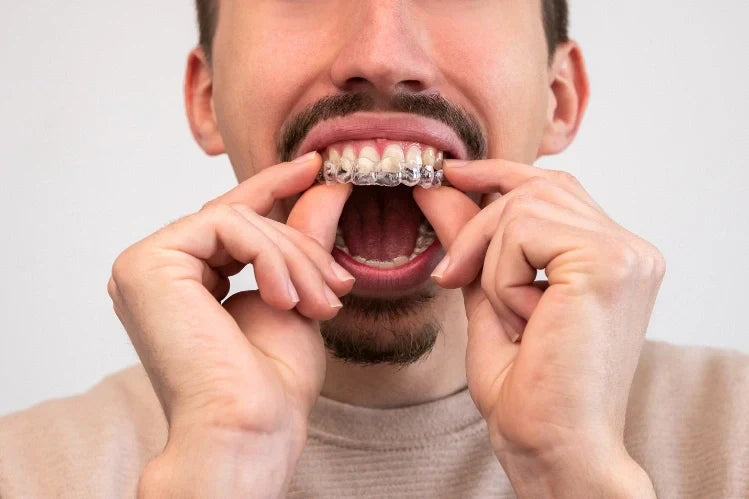
Table of Contents
- What Is a Retainer?
- Why Retainers Are Essential after Braces?
- How Long Does It Take to Adjust?
- Understanding Different Types of Retainers
- How to Get Used to Retainers: Tips That Work
- Common Issues and How to Handle Them?
- How to Get Used to Plastic Retainers Specifically
- Introducing ALIGNERCO Retainers
- Adjusting to Retainers—A Matter of Time and Patience
- FAQs
If you recently finished your orthodontic treatment or are on your way to the post-braces period, the question of how long does it take to get used to wearing retainers must be running through your mind.
Anyone who’s ever popped a retainer into their mouth for the first time knows—it’s not just about the timeline. It’s about the feel, the adjustment, the unexpected drool, the speech changes, and even the little frustrations.
This guide is your go-to resource. It is not just about timelines—it’s about helping you feel prepared and empowered as you adjust to this important phase in your orthodontic journey. Whether you are wearing a clear plastic retainer, a Hawley, or a permanent wire, we’ll break it down in a way that makes sense and helps you adapt comfortably.
What Is a Retainer?

A retainer is a custom-made dental appliance that helps maintain your teeth's new alignment after your orthodontic treatment. Think of it as a loyal guardian—its job is to prevent your teeth from shifting back to where they used to be before braces or aligners worked their magic.
Retainers can be:
- Removable, like the popular Essix (clear plastic trays) or the Hawley (metal and acrylic).
- Fixed, like bonded retainers that stay behind your teeth.
Each comes with pros and cons, which we’ll get into soon.
Why Retainers Are Essential after Braces?
Let’s be clear: braces or aligners move your teeth. But once those appliances are removed, your teeth can still be uncertain about their final position. That’s where retainers come in—to solidify the work done.
Here’s why they matter:
- Your periodontal ligaments are elastic. They need time to “settle” into your teeth’s new positions.
- Your body is still changing. Especially in teens, natural growth can influence alignment.
- Habits like clenching, grinding, or even certain sleeping positions can subtly shift your teeth out of place.
Without retainers, all your progress could slowly (or quickly) fade away.
How Long Does It Take to Adjust?
The golden question. In general:
- Most people start feeling okay within 3 to 7 days.
- It may take about 2 to 4 weeks before the retainer feels completely natural and unnoticeable.
A Breakdown:
- First 1-2 days: You’ll likely notice soreness, slight difficulty talking, and excessive saliva.
- Days 3–7: Your mouth begins to adjust, and things start to feel more normal.
- Weeks 1–4: The retainer feels like second nature. You may even forget you’re wearing it.
Remember: Consistency is everything. The more you wear it, the faster you’ll adjust. Taking breaks or wearing it inconsistently only prolongs the weird stage.
Understanding Different Types of Retainers
Clear Plastic Retainers (Essix)

These sleek, transparent trays are molded to fit your teeth exactly. They’re great for aesthetics and are especially popular among adults.
- Adjusting Time: 3–5 days for discomfort, 1–2 weeks for full comfort.
- Pros: Nearly invisible, lightweight, custom-fit.
- Cons: Can warp in heat, needs daily cleaning, may not last as long.
Hawley Retainers (Acrylic and Metal)

The “classic” retainer. It uses a plastic base and a wire that runs across the front of your teeth.
- Adjusting Time: 5–7 days for soreness, 2–3 weeks for speech adaptation.
- Pros: Long-lasting, adjustable, allows a natural bite.
- Cons: More noticeable, bulkier, may affect speech longer.
Permanent or Bonded Retainers

These are thin wires glued to the back of your teeth, typically the lower front ones. You can’t remove them, which is great for compliance.
- Adjusting Time: 2–5 days for tongue discomfort, 1–2 weeks for full adjustment.
- Pros: Always in place, invisible, zero chance of forgetting.
- Cons: Harder to clean, flossing is a challenge, and may irritate your tongue initially.
How to Get Used to Retainers: Tips That Work
If wearing retainers feels uncomfortable at first, don’t worry—you’re not alone in this experience. These practical, proven strategies can help you get comfortable with them faster and more easily.
1. Wear Them as Directed
Your orthodontist likely instructed you to wear retainers full-time for the first few months. Being consistent not only helps your mouth adjust quicker but also prevents your teeth from shifting back.
“Wearing it consistently helps your mouth adapt faster. Taking it off too often just makes it harder,” says Dr. Lisa Gray, an orthodontic specialist .
2. Talk Out Loud
It’s normal for your speech to sound a little different at first. Reading aloud or singing with your retainer can help your tongue and lips adjust quickly.
3. Drink Plenty of Water
Retainers can trigger more saliva production at first. Staying hydrated helps manage this and keeps your mouth feeling clean and refreshed.
4. Clean Retainers Regularly
Neglecting to clean your retainers can lead to unpleasant tastes, odors, or even infections. Use a soft-bristled toothbrush and lukewarm water to clean them gently but thoroughly daily.
5. Be Patient
Adjustment takes patience. Most people feel normal within a week or two, and the long-term benefits of a straight smile far outweigh the short-term hassle.
Common Issues and How to Handle Them?
Sore Teeth
Why: Your teeth are settling into their new positions.
Fix: Try over-the-counter pain relievers like ibuprofen and eat softer foods until the soreness subsides.
Lisping
Why: Your tongue needs to adjust to the retainer’s shape.
Fix: Practice speaking challenging words; it typically improves with repetition and time.
Excessive Saliva
Why: Retainers are a new object in your mouth.
Fix: Sip water or chew sugar-free gum to manage the extra saliva.
Difficulty Sleeping
Why: Your brain treats the retainer as a foreign object.
Fix: Stick with your nighttime routine; most people get used to it after a few days.
How to Get Used to Plastic Retainers Specifically
If you’re using a plastic Essix-style retainer, here are some bonus pro tips:
- Rinse it with lukewarm water before putting it in. It softens the plastic slightly.
- Avoid heat. Hot drinks, hot water, or a warm car can warp it.
- Use a case, always. Don’t wrap it in a napkin (you’ll lose it).
- Check the fit regularly. If they start to feel loose or tight, check with your orthodontist.
When to Call Your Orthodontist (H2)
While some discomfort is expected, these signs mean it’s time to book an appointment:
- Pain that doesn’t go away after 7–10 days
- Sores, cuts, or bleeding
- A retainer that feels too tight or too loose
- Speech issues that don’t improve
- Damage or visible warping
Your orthodontist can make adjustments or replace the retainer if needed.
Introducing ALIGNERCO Retainers

ALIGNERCO Retainers are essential for maintaining dental alignment after orthodontic treatment. Designed for a snug fit, they help maintain proper teeth alignment after braces are removed.
Key Features:
- Custom Fit: These trays are made in a way that can easily fit your teeth and align them neatly.
- Durable Material: It is made of quality materials to ensure it can be used for many years.
- Discreet Appearance: They are discreet as they have a clear design.
- Effective Maintenance: Assists in controlling teeth movement after treatment has been provided.
- Affordable Pricing: Competitive pricing and flexible payment plans.
- Expert Craftsmanship: Special, individually designed retainers that fit perfectly.
- Seamless Service: A simple ordering process through the professional customer service team.
Adjusting to Retainers—A Matter of Time and Patience
Getting used to retainers—whether removable or fixed—is a process that varies for each person. On average, most people adapt within a few days to weeks. You may feel slight discomfort or pressure and find that your speech is temporarily altered at first, but this is completely normal.
With comfort in mind, ALIGNERCO retainers help ease this transition even more. Made durable from high-quality materials, they fit well and minimize irritation, allowing you to stay on top of your post-care regimen. Whether you're using a general retainer or an ALIGNERCO one, patience and consistency are the keys to long-term success and a smile that lasts.
FAQs
1. Does the retainer lisp go away?
Yes, it usually fades within a few days as your tongue adjusts.
2. Do you ever get used to permanent retainers?
Yes, most people stop noticing them after a short adjustment period.
3. How do I get used to my retainer again?
Wear it consistently, speak out loud, and be patient—it gets easier with time.
4. How long do retainers feel weird?
Retainers may feel odd for a few days to weeks.
Citations:
Littlewood, S. J., Mitchell, L., & Bearn, D. R. (2001). Retention procedures for stabilising tooth position after treatment with orthodontic braces. The Cochrane Database of Systematic Reviews, (4), CD002283.
https://doi.org/10.1002/14651858.CD002283
This systematic review discusses retention protocols and patient compliance, including adaptation periods for retainers.
Proffit, W. R., Fields, H. W., & Sarver, D. M. (2018). Contemporary Orthodontics (6th ed.). Elsevier Health Sciences.
This textbook covers orthodontic treatment and retention phases, including typical adjustment periods for retainers.
Al-Moghrabi, D., & Park, J. H. (2016). Patient experiences and satisfaction with removable orthodontic retainers: A systematic review. European Journal of Orthodontics, 38(3), 258–266.
https://doi.org/10.1093/ejo/cjv051
Review focusing on patient adaptation time and comfort with removable retainers.
Ravindra, R. B., & Jena, A. (2018). Effect of removable orthodontic retainers on speech: A clinical study. Journal of Clinical and Diagnostic Research, 12(6), ZC35–ZC38.
https://doi.org/10.7860/JCDR/2018/32456.11686
A Study measuring how speech adapts over time with retainer wear, indicating typical adjustment duration.
Santoro, M., & Farella, M. (2016). Patient compliance and adaptation to removable orthodontic appliances: A literature review. Journal of Oral Rehabilitation, 43(9), 686–693.
https://doi.org/10.1111/joor.12413
Discusses factors affecting how quickly patients adapt to retainers, including psychological and physical factors.
Grünheid, T., Larson, B. E., & Larson, B. E. (2017). Assessing patient comfort and adaptation to orthodontic retainers: A longitudinal study. American Journal of Orthodontics and Dentofacial Orthopedics, 151(3), 473–479.
https://doi.org/10.1016/j.ajodo.2016.11.017
Reports timelines for patient adaptation and comfort improvement with retainer use.
Liu, X., Xu, T., & Wang, R. (2020). Factors influencing patient compliance and adaptation with clear orthodontic retainers. Journal of Dental Research, 99(7), 770–776.
https://doi.org/10.1177/0022034520917121
Explores how adaptation time can vary based on retainer type and patient-specific factors.
Jayaraman, J., Naini, F. B., & Gill, D. S. (2014). Speech changes and retainer wear: Evaluating duration and severity. European Journal of Orthodontics, 36(6), 720–727.
https://doi.org/10.1093/ejo/cjt073
Analyzes the duration needed for patients to adapt to speech with retainers, which is a key part of overall adaptation.






